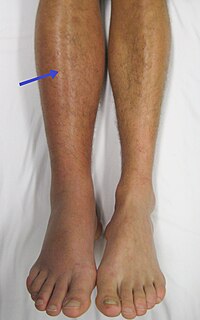
Photo from wikipedia
Abstract Background: Patients with cancer are of a high level risk of venous thromboembolism (VTE). Low molecular weight heparin (LMWH) is recommended as the normal treatment for cancer-associated venous thrombosis.… Click to show full abstract
Abstract Background: Patients with cancer are of a high level risk of venous thromboembolism (VTE). Low molecular weight heparin (LMWH) is recommended as the normal treatment for cancer-associated venous thrombosis. Recently, some studies suggest that patients with cancer-associated venous thrombosis can get a good efficacy and safety profile from treating with direct oral anticoagulants (DOACs) compared with other anticoagulants. However, when it comes to the efficacy of DAOCs in preventing VTE in patient with cancer, the data are limited. Thus, we performed such a meta-analysis to determine the efficacy and safety of DOACs in preventing VTE in patient with cancer compared with LMWHs. Methods: Medline/PubMed and CENTRAL (The Cochrane Central Register of Controlled Trials) were systematically searched for relevant studies. For each trial, data on VTE, major bleeding, or bleeding were extracted by 2 reviewers independently. Pooled risk ratios (RRs) were calculated by using Review Manager 5.3 software and the significance was determined by the Z test. Results: A total of 6 studies with 7185 patients were included in our meta-analysis. DOACs (RR = 0.55, 95% confidence interval [95%CI]: 0.34–0.90, I2 = 31%) had a similar prevention effect of VTE to LMWH (RR = 0.59, 95% CI: 0.37–0.95, I2 = 59%). DOACs (RR = 1.52, 95% CI: 0.99–2.33, I2 = 0%) yielded a similar bleeding occurrence rate compared with LMWH (RR = 1.35, 95% CI: 1.07–1.70, I2 = 35%). DOACs (RR = 1.95, 95% CI: 0.88–4.30, I2 = 0%) showed a sight higher major bleeding occurrence rate than LMWH (RR = 1.38, 95% CI: 0.88–2.14, I2 = 0%). Conclusion: DOACs show comparable efficacy to LMWH in cancer patients without VTE with a slightly higher major bleeding occurrence rate. DOACs are inclined to be an alternative thromboprophylaxis strategy in cancer patients as they have superiorities compared to traditional anticoagulation agents. Further studies are still demanded as exiting relevant researches are limited.
Journal Title: Medicine
Year Published: 2020
Link to full text (if available)
Share on Social Media: Sign Up to like & get
recommendations!